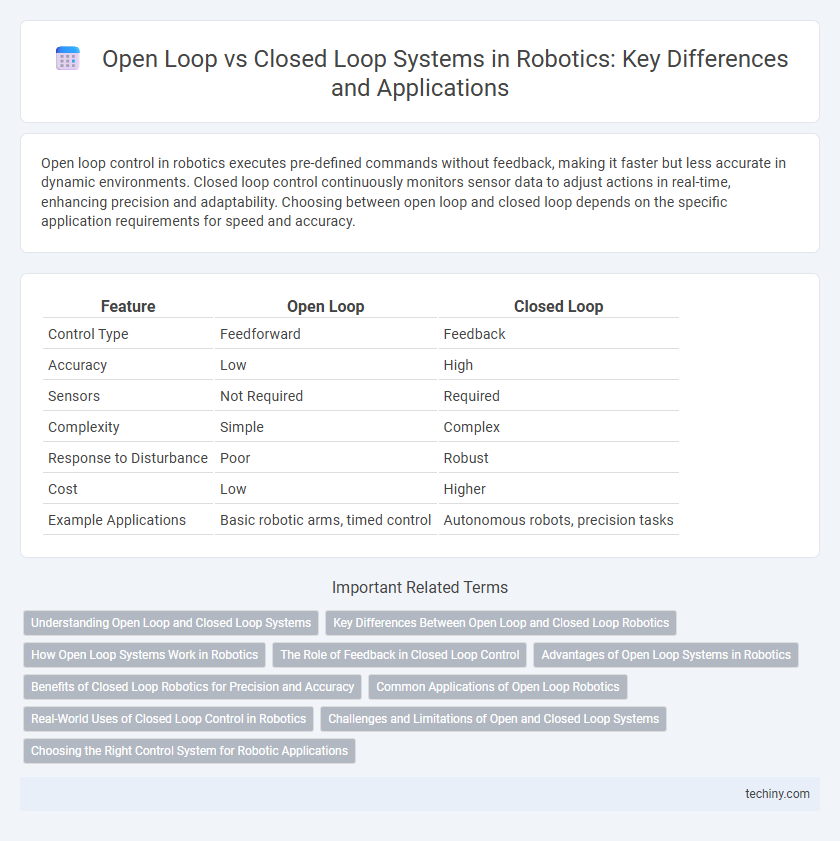Open loop control in robotics executes pre-defined commands without feedback, making it faster but less accurate in dynamic environments. Closed loop control continuously monitors sensor data to adjust actions in real-time, enhancing precision and adaptability. Choosing between open loop and closed loop depends on the specific application requirements for speed and accuracy.
Table of Comparison
| Feature | Open Loop | Closed Loop |
|---|---|---|
| Control Type | Feedforward | Feedback |
| Accuracy | Low | High |
| Sensors | Not Required | Required |
| Complexity | Simple | Complex |
| Response to Disturbance | Poor | Robust |
| Cost | Low | Higher |
| Example Applications | Basic robotic arms, timed control | Autonomous robots, precision tasks |
Understanding Open Loop and Closed Loop Systems
Open loop systems in robotics operate without feedback, executing predefined actions regardless of external changes, which may lead to inaccuracies in dynamic environments. Closed loop systems continuously monitor sensor data to adjust and correct actions in real-time, enhancing precision and adaptability. Mastery of these control strategies is essential for developing robots capable of robust performance and autonomous decision-making.
Key Differences Between Open Loop and Closed Loop Robotics
Open loop robotics systems operate without feedback, executing pre-programmed commands regardless of the outcome, resulting in lower accuracy and limited adaptability. Closed loop robotics incorporate sensors to provide real-time feedback, enabling adaptive control and precise adjustments during operation. This key difference significantly impacts performance, error correction, and system reliability in robotic applications.
How Open Loop Systems Work in Robotics
Open loop systems in robotics operate by executing predefined commands without feedback or adjustments based on sensor data, relying solely on initial input signals. These systems are effective in environments where tasks are repetitive and external disturbances are minimal, ensuring consistent actuator movements. Examples include simple robotic arms performing pick-and-place operations where precise feedback control is unnecessary.
The Role of Feedback in Closed Loop Control
Feedback in closed loop control continuously monitors the output to adjust the input, ensuring precise system performance and error correction. This real-time data enables robotic systems to adapt to external disturbances and maintain stability during operations. Unlike open loop systems, closed loop control leverages feedback to optimize accuracy and reliability in dynamic environments.
Advantages of Open Loop Systems in Robotics
Open loop systems in robotics offer simplicity and cost-effectiveness by operating without feedback sensors, resulting in faster response times and easier implementation. These systems require less computational power and have lower maintenance demands, making them ideal for straightforward tasks with predictable environments. Their deterministic behavior ensures consistent performance when precise feedback is unnecessary, enhancing efficiency in specific robotic applications.
Benefits of Closed Loop Robotics for Precision and Accuracy
Closed loop robotics enhances precision and accuracy by continuously monitoring sensor feedback to adjust movements in real time, reducing errors caused by external disturbances or system variations. This dynamic correction capability allows for consistent performance in complex tasks such as assembly, welding, and surgical operations. Robots utilizing closed loop control systems demonstrate superior reliability and improved quality outcomes compared to open loop counterparts, making them essential for industries demanding high precision.
Common Applications of Open Loop Robotics
Open loop robotics systems are widely used in applications where feedback is not critical, such as pick-and-place operations, conveyor belt sorting, and robotic painting tasks. These systems execute pre-programmed instructions without sensor feedback, making them ideal for repetitive, high-speed processes in controlled environments. Common industries benefiting from open loop robotics include manufacturing, packaging, and assembly lines where precision feedback is less essential.
Real-World Uses of Closed Loop Control in Robotics
Closed loop control systems in robotics enable real-time feedback and adjustments, enhancing precision and adaptability in applications like robotic surgery, autonomous vehicles, and industrial automation. These systems continuously monitor sensor data to correct errors, ensuring accurate path following, force control, and obstacle avoidance. The integration of closed loop control significantly improves reliability and safety in complex, dynamic environments compared to open loop systems.
Challenges and Limitations of Open and Closed Loop Systems
Open loop systems in robotics face challenges due to their lack of feedback, leading to limited adaptability and reduced accuracy in dynamic environments. Closed loop systems improve precision by using sensor feedback, yet they encounter limitations such as increased complexity, higher costs, and susceptibility to sensor noise and delays. Balancing the trade-offs between responsiveness and system stability remains a critical challenge in optimizing robotic control architectures.
Choosing the Right Control System for Robotic Applications
Open loop control systems in robotics offer simplicity and lower cost but lack feedback, making them less accurate for tasks requiring precision. Closed loop control systems utilize sensors to continuously monitor and adjust operations, providing higher accuracy and adaptability in dynamic environments. Selecting the right control system depends on the application's complexity, desired precision, and budget constraints, with closed loop systems favored for advanced robotic applications requiring real-time adjustments.
open loop vs closed loop Infographic

 techiny.com
techiny.com